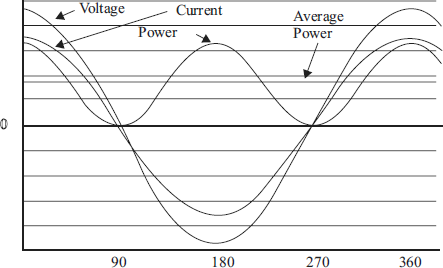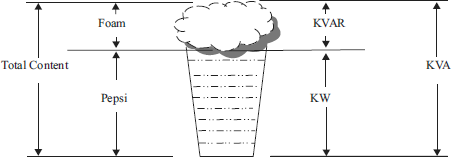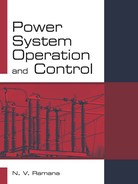8.3 REACTIVE POWER
In a purely resistive AC circuit, voltage and current waveforms are in phase and reverse their polarity at the same instant in each cycle (illustrated in Fig. 8.3). When reactive loads are present (such as capacitors or inductors), energy is stored in the form of electric or magnetic fields respectively in the loads during part of the AC cycle and results in a time difference between the current and voltage waveforms (for a capacitor, current leads voltage; for an inductor, current lags voltage). This stored energy returns to the source during the rest of the cycle and is not available to do work at the load. This energy, continuously flowing back and forth (to and fro), is known as reactive power while the active power flows from one point of the network to another. For a complete cycle, the net reactive power flow is zero as the energy flowing in one direction for half a cycle is equal to the energy flowing in the opposite direction in the next half of the cycle.
Let us consider a simple analogy to understand these terms active power, reactive power and apparent power clearly.

Fig 8.3 Waveform
Consider that you have ordered a chilled Pepsi (cool drink), feeling thirst on a sunny day. Now observe the content of the glass immediately after Pepsi was poured into it. You observe some bubbles (foam) at the top of the glass. The total content of the glass is the summation of the foam and the cool drink. Now we correlate this setup with our problem. This correlation is illustrated in Fig. 8.4.

Fig 8.4 A glass of chilled Pepsi
It is obvious that the thirst quenching quantity is the cool drink and not the bubbles (foam) formed at the top of the glass. In other words, we can say that while useful work (thirst quenching) is done by Pepsi, the foam does not quench the thirst. But it is part of the total content and we have to accept it.
Let the thirst-quenching portion of the glass (Pepsi) be represented by KW
Let the foam formed on the top of the glass be represented by KVAR.
The total content of the glass, KVA, is this summation of KW (Pepsi) and KVAR (the foam). Practically KVA is the vectorial summation of KW and kVAR.
We know that, the power factor is,
Since KVA is equal to the vectorial summation of KW and KVAR,
P.F = KW/vectorial sum (KW + KVAR) ≅ Pepsi/Pepsi + Foam
Thus, for a given KVA we can deduce that,
- The more bubbles (foam) the glass contains (the higher the percentage of KVAR), lower the ratio of Pepsi (KW) to Pepsi plus foam (KVA). Therefore the power factor will be low.
- The less (bubbles) foam the glass contains (the lower the percentage of KVAR), the higher the ratio of Pepsi (KW) to Pepsi plus foam (KVA). Therefore the power factor will be more, or approaches unity.
We all know that if we poul Pepsi into a glass, it generally has a head of foam on it.
Let us imagine a new policy – You pay only for the Pepsi and not for the foam. While the foam is just aerated Pepsi, it is not really a pleasing quantity in that form. If the glass of Pepsi contains half foam, you pay half the price.
It is the same principle applied to electricity generation – the consumer only pays for working or real power and not the reactive power.
8.3.1 Sources of Reactive Power
The main sources of reactive power are given below.
1. Overhead Lines: When current flows through a line it produces a magnetic field that absorbs reactive power, given by I2X where I is the current flowing through the line and X is the reactance of the line in ohms per phase. A lightly loaded overhead line is a net generator of reactive power, whereas a heavily loaded line is a net absorber of reactive power. However, underground cables have a small inductance and relatively large capacitances due to closeness, large size of conductors and high relative permitivity of the dielectric material used. Hence, they generate reactive power.
2. Transformers and Motors: Transformers produce magnetic fields and therefore absorb reactive power. Inductive loads such as motors (any type of wound coil) absorb reactive power with their current waveform lagging the voltage.
